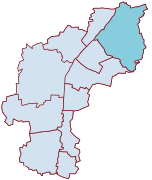Pottenbrunn
|
|||
| Basic data | |||
| Surface: | 17.94 km² | ||
| Residents: | 2,493 (December 31, 2015) | ||
| Population density: | 139 inhabitants per km² | ||
| Height: | 244 m above sea level A. | ||
| Post Code: | 3140 | ||
| Geographical location: | 48 ° 14 ' N , 15 ° 42' E | ||
| Cadastral communities | |||
|
|||
| Location in St. Pölten | |||

|
|||
The town of Pottenbrunn is located in Lower Austria on the Traisen and the S33 between Herzogenburg and St. Pölten , from where it is about seven kilometers away. It has been a district of St. Pölten since its incorporation in 1971 .
The districts of Radlberg , Ratzersdorf and Wagram border on Pottenbrunn . In the east the town borders on Böheimkirchen , in the northeast on Kapelln and in the north on Herzogenburg .
Surname
The name Pottenbrunn, originally called Potilinesprunnin or Potinbrunnin, can be traced back to a settlement that was near a well and belonged to a certain Poto or Potilo. The name Wasserburg can be traced back to the castle around which the village was built.
history
The area of today's Pottenbrunn was already settled in the Neolithic Age, which is proven by various finds.
The place emerged from the two originally separate and under different manorial rule places Ober- and Niederpottenbrunn, which until 1623 each had a church and a school.
Pottenbrunn was first mentioned in 890 as Potilinesprunnin. One of the two centers was probably called Wihselbrunne around 1200.
Ober- and Niederpottenbrunn were administered by different landlords. A document dated May 19, 1353 shows two seals: one from Jans von Pottenbrunn (owner of the old castle), who belongs to the Knights of Pottenbrunn, and one from Jans Alachter von Pottenbrunn. The two Jans were cousins.
The lower parish church of the Holy Cross , which burned down in 1637 and was largely destroyed by the Turks in 1683, was finally demolished in 1730. The upper church of St. Ulrich was built around the year 1000. It is today's parish church .
In 1927 Pottenbrunn was raised to market under Mayor Anton Hinterwallner (1927–1938) .
In 1972, the independent market town of Pottenbrunn was incorporated into the city of St. Pölten following a resolution by the Lower Austrian Landtag amid great protest by the population. 95% of the Pottenbrunn population signed a statement against the incorporation . The local council unanimously decided to reject it, but this did not bring the desired success.
politics
As the cadastral municipality of St. Pölten, Pottenbrunn does not have its own municipal council; the mayors before 1972 can be found in the list of mayors of St. Pölten .
Public facilities
schools
- Secondary school with a focus on ecology
- Elementary school
- Learning workshop Pottenbrunn, a private school with public rights, based on the pedagogical principles of Piaget and Rebeca and Mauricio Wild.
Health and social
In Pottenbrunn, next to a nursing home, there is a rescue center run by the Arbeiter-Samariter-Bund .
Culture and sights
- Pottenbrunn Castle , a renaissance castle
- Wasserburg Castle , a baroque castle
- Catholic parish church Pottenbrunn hl. Ulrich
- Grave field: The early medieval grave field of Pottenbrunn contains 199 skeletons (49 men, 51 women and 98 children), the majority is very well preserved and could therefore be subjected to a detailed morphological and metric examination.
- The Theater & Show Szenario association has existed since 1999 and has established itself in the central region of Lower Austria during this time. The team has around three productions a year, which are performed in the Pottenbrunn parish hall and in the park of the palace as a summer theater.
- In 2004 the theater ensemble nameless association was founded. Every autumn, the team plays self-written productions in the Volksheim Pottenbrunn.
- Site design
In 1987, as part of the European Entente Florale Europe competition , Pottenbrunn was named the most beautiful flower village in Europe and was awarded a gold medal in the village category.
Personalities
- Emmy Feiks-Waldhäusl (1899–1975), writer
- Adele List (1893–1983), milliner
- Emil Schmid (1912–1994), painter and graphic artist
Web links
Individual evidence
- ↑ Magistrate of the City of St. Pölten: Annual Statistical Report 2015.
- ↑ Active weeks in Pottenbrunn. On the history of the districts Pottenbrunn, Wasserburg, Pengersdorf and Zwerndorf. Chapter History, pp. 7–13.
- ↑ http://www.blumenbuero.or.at/



